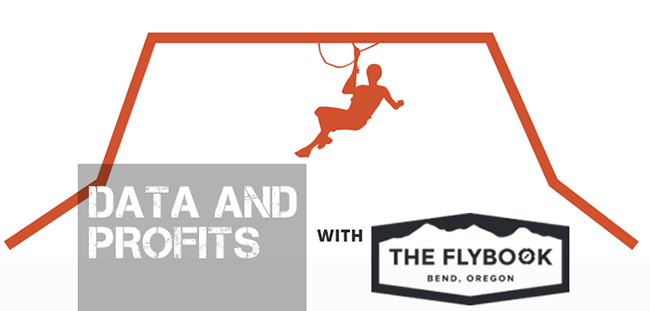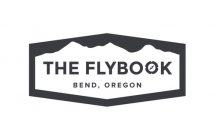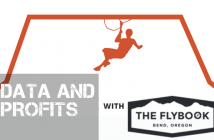“Torture numbers and they will confess anything.”
In part one of this two-part series, we discussed the concept of using data intelligence in your business operations to make tweaks—both large and small—that could increase total climbers, and meet and exceed that magic break-even metric. Specifically, we honed in on increasing your park’s ramp pace, or the time it takes to get to capacity on peak days, and affecting your park’s attendance trends.
Here in part two of the series, we’ll focus on your park’s average ticket price (ATP). This data point significantly impacts overall revenues, profits, and—as some research indicates—your business’ popularity.

Compared to ramp pace and attendance trends, ATP is much more straightforward. The math to determine your ATP is uncomplicated, and it is part of the simple break-even equation (number of climbers x average ticket price). Obviously, increasing average ticket price will increase revenue (assuming visitation remains steady). Keeping track of it over time makes it a great indicator to set long term goals against. Managers can evaluate this number, and if applicable, the change in this number, to gain valuable insight into its strength (steady or increasing), or lack thereof (declining).
The Declining Average Ticket Price Data point
While it’s easy to determine what your ATP is, evaluating the cause of a decline or an increase in ATP can be quite complex. It could be signs of changes in the relationship between supply and demand. It could be a result of price being unclear, too low, or other variables.
Your prices and pricing structure can send messages to your customers that you might not realize. In fact, some data professionals make entire careers out of consulting on pricing strategies. There are scientific studies and textbooks written about it, and even psychologists have put their two cents in (pun intended) with theories around the psychology of buying.
In this article, we’ll explore how people react, both consciously and sub-consciously, to prices.
While there is a dizzying amount of research available, let’s focus on three of the most relevant causes for an adventure park company’s declining average ticket price, and recommended solutions to recover it.
Cause #1: Analysis Paralysis
Studies have shown that too many choices in products and prices can slow down, or in the worst cases discourage, the purchasing process. Pricing structure and the value applied to products play a major role in consumer buying decisions.
According to research out of Yale, if two similar items are priced the same, consumers are inclined to defer their decision instead of actually take action. In one experiment, researchers offered participants the choice to buy one of two different packs of gum, each priced at 64 cents, or pass and keep the money. Only 46 percent made a purchase. On the other hand, when the packs of gum each had a unique price—62 cents and 64 cents—more than 77 percent of consumers chose to buy a pack, demonstrating that using price to differentiate actually increases consumer inclination to purchase.
Along the same lines, there is the theory around “price anchoring.” Anchoring is a common cognitive bias and refers to the “human tendency to rely too heavily on the first piece of information offered when making decisions.”
In an experiment designed to explore effects of price anchoring, researchers performed three tests with the price of beer at a bar. The constant in all three is a beer priced at $1.80. When a premium (i.e., more expensive) option was offered along with the constant, four out of five people chose the premium option. When a cheaper option was added to the constant and the premium priced beers, suddenly the value of the constant appeared more attractive and 80 percent of participants chose it.
The most successful test (from the business’ perspective) was when the added third option was more expensive than the original two: everyone chose the two more expensive options, not one chose the constant.
This experiment, and others similar to it, shows that people want quality and don’t mind paying for it. In consumer’s minds, the price of a product subjectively correlates with quality when compared to other similar—or even same—products. This is called “perceived value.”

You can see how this idea can be translated and applied to adventure parks and zip line operations. Do you have too many tours, products, or ticket types at similar price points? Does it confuse customers, and actually discourage them from making a purchase? Can you add a premium priced offering for the segment of people who always want the very best and perceive price to be a symbol of that?
You could also use that high-end product to position your best-selling product as well priced. As the beer study illustrates, it’s important to experiment with pricing and apply value to your products in order to differentiate them from one another.
Both experiments illustrate the importance of simple, tiered pricing structures that make it easy for consumers to make buying decisions. Understanding this facet of consumer psychology can play a positive role in increasing your average ticket price—and hopefully overall visitation—for the long-term.
Cause #2: Pricing Is Too Low Or Fear-Based.
New business owners who are not yet fully confident in their product have a tendency to start out with low, introductory prices. It’s understandable, and likely the result of an eagerness to gain customers and get business rolling. However, the customer may actually be willing to pay much more. In fact, it’s been found that most people are more interested in whether your offering will meet their needs rather than how much it costs.
When you are living and breathing it every day, it’s easy to forget that the experience at an adventure park is incredibly unique. For some guests, it’s a once in a lifetime adventure—and one they are willing to pay for, especially if the operation has thoughtful staff, high-quality facilities, and offers little things (photography service, etc.) that make it extra special.
In line with the idea of perceived value, many consumers believe “you get what you pay for.” If your price is too low, a potential customer will mistakenly conclude you don’t have much to offer them, and as a result they won’t delve any further—the low price made the decision for them.
And while making more profits is the ultimate goal, it’s not the only rationale for charging a reasonably high price from day one. Hidden costs in this business are likely if not inevitable, costs that may surprise you after things get going. Protecting margins early on can be the difference in keeping your doors open.
Premium pricing has shown to be effective for fields like ours that tend to have strong barriers to entry, such as those with high startup costs and/or significant marketing costs. A higher price illustrates confidence in the inherent value of your product or service. On the other hand, owners should ensure their marketing efforts, the product, and the park’s look and feel all combine to support the premium price.
We heard a great example of this from Treetop Trekking in Canada. The company’s many park locations offer a top-notch experience with great staff, excellent courses, and an attractive and easy-to-use website. The zip line and aerial game trek is its most valued and popular product. For many years, the company also offered customers standalone zip lines at several locations, which were included in the treks at no additional charge, but not everyone opted to do it.
In 2016, Treetop Trekking made the standalone zip lines an optional add-on to the trek for an additional price (ranging from $10-$15), and it was a hit. The popularity of this add-on not only resulted in increased sales, but it also helped with scheduling staff, which reduced labor costs. Buyers can be more willing to pay if they believe that a higher price signals higher quality.
Cause #3: The number 9 and other funny human behavior.
We are all human, and our minds sure work in mysterious ways. That’s why “pricing psychology” is a professional practice among those who study the human mind and its functions. Surprising tweaks in how pricing is presented can factor significantly in how consumers perceive price, how they perceive your brand and how they react to it, almost certainly subconsciously.
The number 9:
Professor Robert Schindler, a marketing professor at Rutgers Business School, conducted a study of a women’s clothing retailer. He found that the 1 cent difference between prices ending in .99 and .00 had “a considerable effect on sales,” with items whose prices ended with .99 far outselling those ending with .00. While we definitely think we know better, humans tend to think of $4.99 as being more closely related to $4 than $5.
The journal of Quantitative Marketing and Economics agrees. Its in-depth research shows prices ending in 9 were so effective they were able to outsell even lower prices for the exact same product. In comparing sales of women’s clothing priced at $35 versus $39, the study found that the clothing selling at $39 outperformed the lower price on average by more than 24 percent.
The $ sign:
Researchers at Cornell University played with the actual dollar sign symbol in their study. As it turns out, the decision to include that little symbol (or not) makes a big difference. When the prices were listed with the dollar sign, customers spent less. Conversely, when the dollar sign was absent, they tended to spend more. People are more willing to spend if an item is listed as “49” as opposed to “$49.”
Why? It seems that when a currency sign appears with the price, we automatically connect it to our own wallet—and what is or isn’t inside there—leading us to believe the item in question is more expensive than it actually is.
As previously mentioned, the research and do’s and don’ts around pricing strategy are overwhelming. These are just three scenarios to consider, but much more is written on this topic. Quickbooks has a good resource on pricing strategies and advice if you’re interested in more. Bottom line: price is a key component that has a very strong cause-and-effect relationship to average ticket price.
A related hot button for many in this industry is aggressive (potentially positive or potentially counterproductive) discounts and promotions. So last up in this data series, we’ll look at promotion data points and their behavior, and talk about some key tips to successful promotions without eroding ATP.






